20国际营销 英文版 课件 (15)
- 格式:pptx
- 大小:585.75 KB
- 文档页数:29
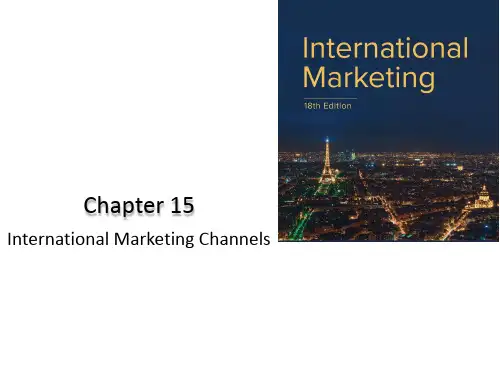
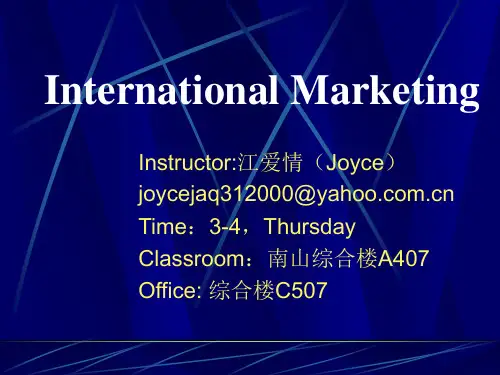

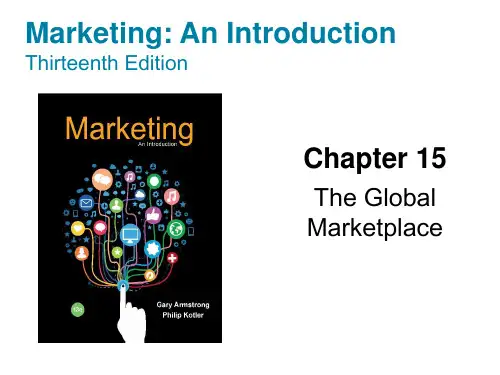
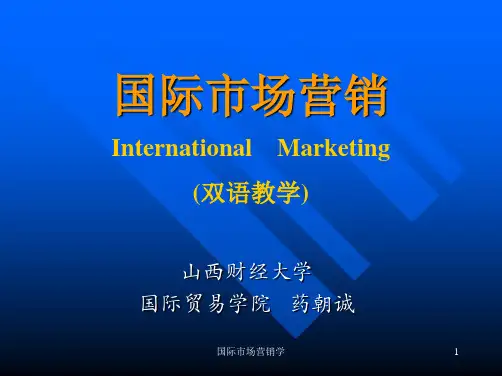
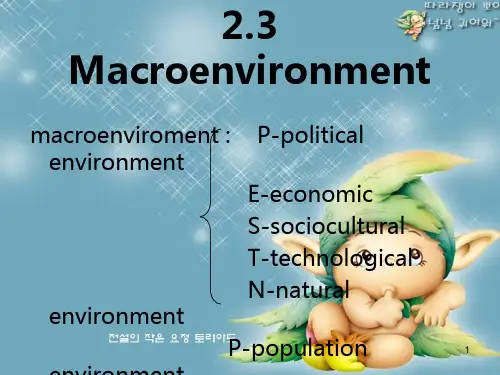
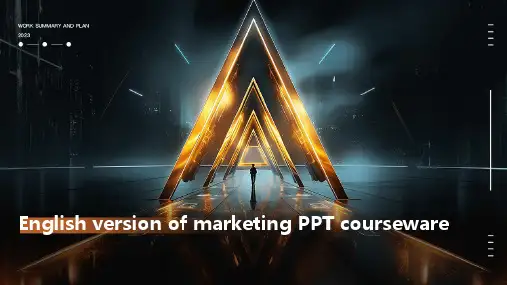
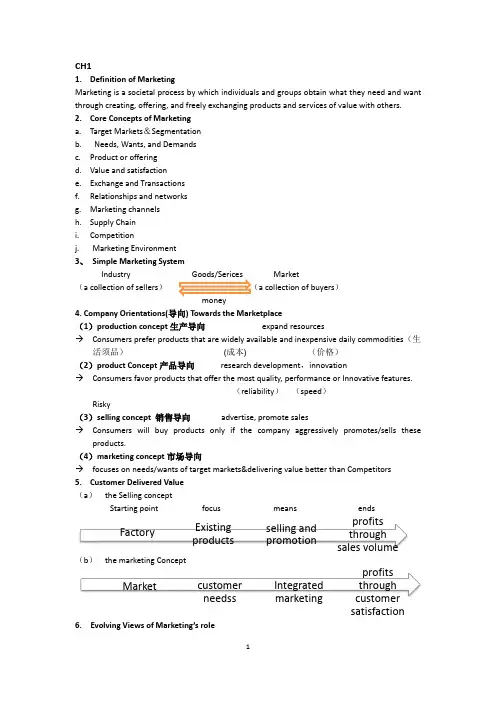
CH11. Definition of MarketingMarketing is a societal process by which individuals and groups obtain what they need and want through creating, offering, and freely exchanging products and services of value with others. 2. Core Concepts of Marketinga. Target Markets &Segmentationb. Needs, Wants, and Demandsc. Product or offeringd. Value and satisfactione. Exchange and Transactionsf. Relationships and networksg. Marketing channelsh. Supply Chaini. Competitionj. Marketing Environment 3、 Simple Marketing SystemIndustryMarket(a collection of sellers ) a collection of buyers )4. Company Orientations(导向) Towards the Marketplace(1)production concept 生产导向 expand resources→ Consumers prefer products that are widely available and inexpensive daily commodities (生活须品) (成本) (价格) (2)product Concept 产品导向 research development ,innovation→ Consumers favor products that offer the most quality, performance or Innovative features.(reliability ) (speed )Risky(3)selling concept 销售导向 advertise, promote sales→ Consumers will buy products only if the company aggressively promotes/sells theseproducts. (4)marketing concept 市场导向→ focuses on needs/wants of target markets&delivering value better than Competitors 5. Customer Delivered Value(a ) the Selling conceptStarting point focus means ends(b ) the marketing Concept6. Evolving Views of Marketing’s roleprofits through sales volume selling and promotionExisting products Factoryprofits through customer satisfactionIntegrated marketingcustomer needss Marketa Marketing as an equal function b. Marketing as more important function. ProductionC.Marketing as the major function d . The customer as the Controlling factor other sections need to Serve for Marketing and achieve the marketing needse. The customer as the Controlling function and marketing as the integrative function.project manager 项目经理→Solve Customer’s problems and Contact the customers 7. need 、want 、 demandneed: basic requirements for people’s survival ( food, clothes ) want: more advanced/specific requirements (coke, KFC )demand: not only specific requirements but also the ability of payment 8. The Four Ps The Four Cs Marketing Mix (营销组合)【Combination of techniques and skills and marketing condition 】➢ Product →Customer Solution (not only Consider the quality, performance, features ofproducts but also brand, related service)➢Price→定价cost of production, profits, demand, competitors.➢Promotion→specific methods used to push customers to buy product(gifts. discount, Coupon)give stimulators➢place→move the product from the manufacturer➢where we buy→retailers (distribution channels), where the market locatedThe Four Cs➢Convenience for place➢Customer Solution products + services➢Customer Cost customers are more likely to but Products with more convenience➢Communication for Promotion information about the product, company, promotional information(benefits)though media, face-to-face communications9. Customer Satisfactioncustomer Satisfaction →value →benefit ÷cost①increase the benefits and reduce the costs at the same time→technology changeiphone, car②increase the benefits reserve the cost steady at the same time→手机、加量不如价③reserve the benefits and reduce the costs at the same time→促销(New Arrival)④increase the benefits by more than increasing the cost→iphone Plus⑤reduce the cost by more than reducing the benefits10.transaction 交易five Conditions must be satisfied to achieve transaction①at least two parties②each party must have something valve to the other party③each party is capable of the ability of communication and delivery④each party believes appropriate or desirable to deal with other parties→both of them canbenefit from the transaction not a zero Sum game but a win-win gameone winner one loser⑤each party is free to accept or reject the exchange and offer→not much interference(government)11.Scope of market10 terms of entity can be marketeda)Goods产品(physical goods实物)b)Service 服务(insurance, security, medication)c)idea (innovation, creation, new tech, small company with technology sell itself)d)persons (组织人)e)information→Culture related products→movief)property→expensive product(real property不动产house, building)real estate 房地产(persuade to buy real property)financial property(stock、bound债秀、future期货)g)experience体验→theme park、翔伞、真人CSh)event→Olympic games, Expo, Shows, trade fairi)place→scenic sports, cities, countries (investment)j)organization→(universities, hospital,museum)12.Four levels of Competition1)brand competition→company Sees the competitors as other companies offering same products or Services to the Same customers at similar prices大众Vs丰田top and second in sales, same level of salesprice花冠、高夫w迈腾-suv途锐in2)industrial competition→company Sees the competitors as all companies that make the same products 大众VS宝马VS奔驰VS起亚all provide cars, how to compete with othersdesign a new model 向上→辉腾向下→高尔夫(cheap)多品牌竞争大众(斯科达、西雅特)宝马BMW斯莱斯(奥迪、宾利)mini cooper(兰博尼、布加迪)3)form competition→company sees the competitors as all the companies that supply the same services 大众→transportation→motor bike BMW produces motor bike本田、雅马哈、川崎摩托车4)generic Competition→company sees the competitors as all the companies that compete for the same customers'dollars大众→people→same sun of money 10万(car/house/travel)CH2 Winning Markets: Market-Oriented Strategic planning1.market-oriented strategic planningachieve profits and growth➢objectives→start from the Head office to each division➢resources→money, human resources, capital., raw material.(skilled workers, basic labor)Relations, technology resources, place resources➢skills→Special methods will be used or applied to achieve or realize the objectives➢opportunity→policy(reform and opening up, e-car, government Support, diplomatic relationship)Japanese cars→USA(economical)oil crisisbusiness unit业务单位2.objectivesCorporate and division strategic planningbusiness unit planningthe marketing processproject level planningthe marketing plan3.Strategic-Planning, Implementation and Control ProcessPlanning Implementation Control4.Define the corporate mission→What shoud be done for the company*values: culture of company*competitive Scopes:a)industry Scope→industry or range of the industry in which the company operate美的→家电领城(白色)索尼→电子产品奥克斯空调→车b)products and application scope→the product that company will supply富士康OEM provides services for big companyc)Competence scope竞争力→know the range of technology and other core competence董明珠→空调、电池NEC→TV、laptopapple→iOS, Chips, designingd)market Segment Scope→the type of market or the customersthe company will serve→group of the customers sharing same similaritybased on education, income, age…phones→income,age,sexe)vertical scope 垂直范围→the company have the number of channellevels from raw materials to final products and distnbution→Start with one Company and end in another companyDesigning, manufacturing, resembling, distributingonly cover one industry that they have advantage in apple: design, marketing, never produce raw material, never resemble productsf)geographical scope→range of regions and countries in which the company will operaterestaurant→local5.Establishing Strategic Business Units(SBU)建立战略义务单位*three characteristics of SBU①It’s the Single business, which is separated from the rest of the companyBMW -lots of sections, but it has different business unitsSBU- motorbike②It has it’s own Competitorsmotorbikes of BMW VS雅哈…→摩托③It has its own manager who is responsible for strategic planningand profit, performance管宝马摩托的经理与管宝马汽车的经理是平级的*Sign分配how to sign the resources?to the business unitsin order tohead office must evaluate the performance, profit, potential of the business unit.(重点)The Boston consulting Group's Growth Share Matrix矩阵Question Mark➢high market growth rate and low market share➢most business units Start from question mark➢need a lot of money, investment, resources to develop its market shareexpand the production→buy more machines, raw materials, hire more employees, build more factories➢result: not sure they have to think hard whether to continue to pour their money into this or not●Stars(不一定赚钱,甚至还需要继续投资) most shining ones 最需要钱→are the leaders of high market growth rate and high market share→Star was question mark oncealways show great performance in both growth market&market share*Where star makes money?Star不定赚钱公司要继续砸钱以保持优越Star doesn’t necessarily make a profit, the company still need to continuously pour the cash (money)to reserve the high growth rate&market share●Cash Cow最赚钱impossible to develop quickly→is the former star of slow growth rate and the largest market share→produce a lot of cash for the company*why?1)the largest market share2)higher profit rate利润率→pays the company’s bills Income heavily rely on cash cowit supports"other business units●Dogs不赚钱,甚到还会亏→are business units with weak market share→in low growth market maybe from cash Cow or question marks→make low profits or even lossSpecific Strategies for each sale (不是一一对比,一个sale可用1-2个strategy)(a)build the object of build strategy is to increase the market share even giving up short-term earning if that purpose of achieving.it is necessary→always need large investmentappropriate for question Marks/ Stars until it becomes star饿了么滴滴、支付宝红包、微信摇一摇→billions dollars for marketing(b)hold to preserve market shareSuitable for strong cash cow→mate sure it can continuouslyAchieve positive cash flow foreign language training young students’ study(c)harvest increase the short-term cash flow regardless of the long-term effect, make sure to make money within a short period of time→don’t care about the futuremaximize the use of the final profitwithdraw the business and get money back quickly reduce the cost input成本下降利润上升→cast flow reboostedSuitable for dog, question mark, weak cash cow马自达内置差一点,价格降一半4)divest剥夺放弃to sell the business because the resources can be better used elsewhere sell stars, question marks to Small company诸基亚手机大公司垃圾是小公司的宝贝Product Life Grade Theory (three stages)(USA→always new products)1) new product Stagenew product will only be produced and sold in the United States because of lag:A. imitation lag 模仿滞后(it takes time for another country to make similar product, long time to copy or imitate train employees)B. demand lag 需求滞后(they have no idea about the product. It takes time to develop a market and create demand)2)maturing stageexport this new product to other developed countries (similar market Condition→income, interest, habit)make the same product in Eu and Japan, sell them to the local market→production cost, transportation cost, better local servicelocalization export↓try to buy the same product from other developed countries→economic choice, manufacture advantages3)standardized stageeven the developing countries can make the same product, have quality control, more manufacture to developing countriesgive up manufacture and buy products*How does the USA reserve its advantage in export? Innovation.CH3 Analyzing Consumer Markets and Buying Behavior**Buying Behavior: Study how individuals and groups, organizationsSelect, buy, we, and dispose of goods, services, ideas or experiences tosatisfy their needs and desires. 1. Simple Response Model (external 外部)↓ ↓sales promotion: discount internal decision advertising based on personalities reference group age, gender government)①Economic : policy →exchange rateRevaluation of RMB →buy abroadDevaluation of RMB →buy domestic products 贸战②IT →buy online(不针对某品)③political: 萨德,中韩关系break of the relationship④Cultural: culture -related productsHollywood movies, KFC, MCCultural Factors1. Culture is the most foundamental determination of the people’s behavior.When a child grow up in the USA, he/she is exposed to these cultural values: freedom, achievement and success individualism ……(1)freedom : independence (leave family earlier than in China )right(do sth. freely ) (2)achievement and success: how much contribution you can make to the society(3)individualism: emphasize on individual characters and seek more individual benefits or rights(4)efficiency and practicability: 效率和实践性trying is encouraged深圳速度→efficiency(5)material comfort物质享受(6)humanitarianism人道主义2. Subculture→each culture consists of smaller subcultures that provide morespecific identification and socialization for their membersnationality国籍racial groups种族geographical region地理位置在美中国人→餐饮、IT黑人→taxi driver白人→businessdo similar things3.Social class→are relatively homogeneous and divisionalthey are hierarchically or deal and their members share similar valves, interests and behavior, show distinct products and brand preference→income, education and occupationPeople in the USA are divided into 7 cases.1)Top class: “upper upper”less than 1%of USA’s population→Social elites who live on inherited wealth, they give large sums to charity and maintain more than one home. They send their children to top Schools.This small group serves as a reference group for others.标杆make contribution to the country表率作用how much you donate this year2)“lower lower":more than 7% of the population→people on welfare, visible poverty, Usually out of work and some of them are uninterested in finding a permanent work. most depend on the charity, social aid for income→jobless people, don’t like to workbeg restaurant for basic food, sleep in the park3)lower upperPeople coming up from the middle class who have earned high income or wealth through professions (professional sills→lawyers, dentists, scientists, engineers)or business, they tend to be active in Social and civic affairs.They buy status symbol products (top brands)and hope to be accepted in the “upper upper”about 2% very rich or powerful in politics施瓦辛格→加州州长4)”middle class”: about 32%, average pay, white and blue collar workersthey often buy -popular products (普通商品not very expensive)to keep up with the trend. they believe in spending more money on experiences for their children and aiming them towards college educationWorking class4. personal influence①age and family life Cycle Stage②lifestyle③occupation→economic circumstance④personality& self-concept5. Maslow's Hierarchy of NeedsSelf-actualization(setf-development and realization)→top class already achieve recognition Esteem needs(self-esteem,recognition)→receive more respect,recognition(donate,buy, luxuries) Social needs(Sense of belonging, love)→学生不买车买衣服书Reflect social status, buy things belong to the group Safety needs(security-protection)→qualityPsychological needs(food, water, shelter)→quantityCH4 Marketing Channels1. What is marketing channels?→refers to the middle man or intermediaries who are involved in the process of moving the products to the buyers and customers.2. two groups of channels1) merchants→deeply involved in buying and selling. They have to buy the products first and then resell. They have the title(ownership) of goods. They make money by price difference.e.g.: distributor 经销商Whole seller批发商retailer零售商exporter →distributor wholesaler →retailer →Individual customers(生产商)middlemanprice increases a lot2) agents→they do not need to buy the products first, they just help the exporter Search for customers and negotiate with the customers on behalf of the manufacturer.Conclude the deal/ transaction达成交易make money by commission(佣金) given by exporterpercent of the total valuese.g.: broker经纪人→use client’s money find business opportunitymanufacturer’s representativessales agent代理商Q: What kind of the product need relatively longer/ shorter channels?Consuming products 消费品→个人longerindustrial products工业品→公司shorter价格敏感、时间宝费→reduce channels3. advantages of marketing channels1)saving exporter’s money and time→if they want to sell products by themselves, they need to establish large Sales department, hire people which need money2) increasing the sales→sell through channels can achieve more sales because they are professionals. local channels know more about the market3) transferring more attention to manufacturer’s main business→manufact→Save all resources on manufact which they are good at and have advantage, same input different output4) improving the service→the channels can provide better service (presell and aftersell)near the customers and know well宝马→4s店→修车4.jobs and functions of agents1) gather information about the potential and current customers2) develop communication to stimulate the purchasing3) reach an agreement on price and other terms, help manufacturer and buyer conclude a dealcontract, delivery, payment, Insurance4) place orders(下订单)with manufacturer5) finance inventory at different levels 库存管理6)provide service of storage and transportation7) provide for buyer’s payment and bills8) oversee监管the extra transfer of ownership from one organization to another5. Commission for agents*On what kind of circumstance the percentage is big/small?Large, long- term order低many competitors →make Compromisesmall, Short-term order高△del credere→payment6. main considerations for agent selection1) make sure the potential agents are respectable businessmen(good business reputation)2)make sure the potential agents have their own resources to access the customers and government3) make sure the potential agents have well-developed facilities to achieve the goals.经营场所premise,location,places of the business→close to customers(office, well decoration, good transportation)good image vehicle5)make sure the potential agents have a long-term interest in handling exporter’s productswilling to sell the product for a long time very risky, expensive (find, confirm) to frequently change agents potential→affect the image7. different kinds of merchants in the market1) distributor direct buyers on manufacturer, given special rights→top level in channel system excusive selling nighty独家经销商≠专卖店in the specific area, this distributor can controlthe sales, other people have to buy from the distributorfirst and then resell2) consignment distributor委托经销商not necessary for consignment distributor to arrange the payment immediately for the goods they bought, pay after successfully selling them lower risk, arrange payment partially(→more troubles for exporters: more paperwork, but higher profits3) import house进口商行Complete transaction 交易not regular buyer,only buy the products when receiving an order help the customer to purchase4) state-buying organizationstate-owned corporationlarge buying quantitygiven special nights and licensescontrol the exporting and importing in specific areasbuy products through these corporation5)wholesaler批发商large buyer, buy products directly from the exporter if there is no distributorlarge quantity and sell to retailer零售商hope to become distributor6) retailer零售商much bigger than any wholesalere.g. Supermarket Chain store沃尔玛buy from wholesaler or directly from the exporterlarge quantity→have more influence on the manufacturerProducts with their own brand→leave the manufacture to other manufacturers·for small manufacturer·sales will increase, less favorable brand image·for big manufacturer, top brand higher price, sales can’t be guaranteed ·increase the sales volume(销售量)·can’t simply reduce the price which would lower the imageCH5 Marketing Communication→”P”romotion1. marketing communication mix→combination of the major skills and techniques for communicating with the customers.①promotional sub mix: short-term marketing objective→increase the sales within a short period of time→manufacturer has to provide specific information about the products and brands to the customers,provide stimulates and incentives to push the buyer to make a decision to buy the product immediatelyAd.discount, off, gifts coupons P.O.P.= point of purchase(place) given directly at the P.O.P(打折,show, try)可以立马买到②Public relation sub mix :→make more people like your company/ brand·focus on long-term marketing objectives·establish favorable brand image or reputation in the market·provide information about the company history, story of the leader - background ·noncommercial media:news, report, documentary→don’t have to payIntel→computer chips CPUAMD→second largest Computer chips manufacture through news (provide scholarship and position for graduates in Suzhou University)(merge with ATI)2. Consideration for marketing communication selection1) product characteristic→different products need different communicationsconsuming products: heavy advertisements, sales promotionindustrial products: personal selling2) marketing objectives→long/short term3) marketing environment→location, culture, political policy, law4) targeted audience→find customers who have the same interest hit the customers who are likely to be persuaded, and final communication is the budget and whether it is acceptable3. Specific techniques and media can be used for the marketing communication1) personal Selling:most efficient way→persuade the buyerhigh success rate but low efficiency 效率低limited coverageface-to-face talking:①give detailed information②Customers achieve more attention③get feedback and response which can be handled immediately*useful for large buyer& expensive products2) special trade presslike magazines, with limited readers, people work in specific industry, more likely to be persuaded and interested in companies introduced in the special trade presse.g.纺织品出版物3)direct advertising(sales literature and direct mail)有联系Sales literature:pointed materials (e.g. pricelist. Brochure. catalogue)it will be given directly to the customersprovide detailed information readers will catch information at their Conveniencehow to? through personal selling, trade fairs, direct maildirect mail: samples (used for confirming the quality of the product)(buyer’s sample -ask manufacturer to produce similar product)gifts (improve the relations with customers)mass media pros: large coverage variety of choicescons: expensivee.g. radio: popular, used when other media are not availablespoken language with music backgroundnewspaper: economic choice, limited coverage, select geographically(local restaurant→local newspaper)relatively detailedInformation, word description and picturesBillboard: improve brand familiarity 品牌熟悉度by repeating many timesmagazine: high-quality photos, more impressive, focus customers with common interest, football magazines( football fans players)。
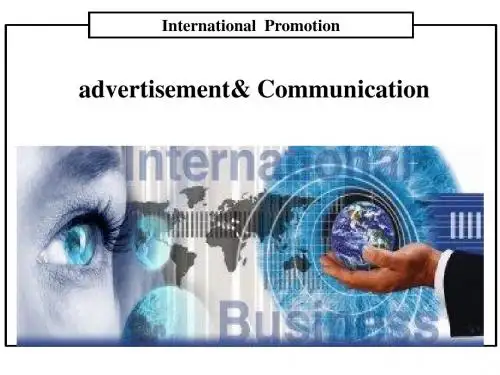
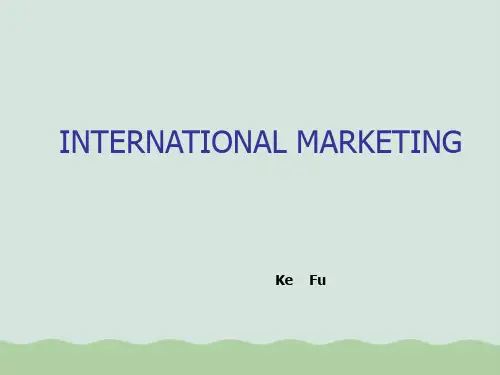
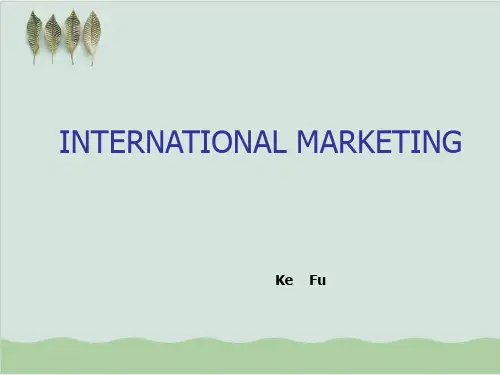
国际市场营销学培训讲义(英文版) International Marketing Training HandbookSession 1: Introduction to International Marketing1.1 Definition of International Marketing- Explanation of international marketing and its importance in today's globalized world.- Overview of key concepts, such as globalization, market segmentation, and cultural diversity.1.2 Benefits and Challenges of International Marketing- Discussion on the advantages of expanding into international markets, such as increased sales and new business opportunities. - Identification of common challenges, such as cultural differences, legal and regulatory complexities, and competitive pressures.1.3 International Marketing Strategies- Introduction to different strategies for entering international markets, including exporting, licensing, joint ventures, and direct investment.- Examination of factors influencing strategy selection, such as market potential, risk assessment, and resource allocation. Session 2: Market Research and Analysis2.1 Understanding Global Consumers- Analysis of cultural differences and their impact on consumer behavior.- Identification of global consumer segments and trends to targeteffectively.2.2 Market Research Methods- Overview of primary and secondary research methods for gathering market intelligence.- Explanation of techniques for analyzing market data, such as surveys, focus groups, and data mining.2.3 Assessing Market Potential- Examination of key factors to consider when evaluating market potential, including market size, growth rate, and competition.- Introduction to tools and frameworks for assessing market attractiveness and competitiveness.Session 3: Market Entry Strategies3.1 Exporting and Importing- Discussion on the advantages and disadvantages of exporting and importing.- Explanation of export and import processes, including logistics, documentation, and international trade regulations.3.2 Licensing and Franchising- Overview of licensing and franchising as market entry strategies. - Examination of the benefits, risks, and considerations involved in entering into licensing and franchising agreements.3.3 Joint Ventures and Strategic Alliances- Introduction to joint ventures and strategic alliances as collaborative market entry strategies.- Analysis of the advantages, challenges, and factors for successful partnerships.Session 4: Product and Brand Management4.1 Adaptation vs. Standardization- Examination of product and brand adaptation strategies to suit local market preferences.- Discussion on the benefits and risks of standardizing products and brands across international markets.4.2 Product Development and Innovation- Overview of product development processes for international markets.- Introduction to strategies for fostering innovation and staying competitive in global markets.4.3 Branding and Positioning- Explanation of brand building and positioning strategies for global brands.- Examination of the role of culture, communication, and customer perception in successful international branding.Session 5: Communication and Promotion5.1 Integrated Marketing Communications- Introduction to integrated marketing communications (IMC) and its role in international marketing.- Explanation of different promotional tools and channels, such as advertising, public relations, and digital marketing.5.2 Cultural Sensitivity in Communication- Discussion on the importance of cultural sensitivity and adaptation in international communication.- Analysis of successful cross-cultural marketing campaigns and the lessons learned.5.3 Digital Marketing in International Markets- Overview of digital marketing strategies and tactics for reaching global audiences.- Examination of the challenges and opportunities in leveraging digital platforms for international marketing.Note: This training handbook provides an overview of key topicsin international marketing and can be customized to suit specific training objectives and participant needs.Session 6: Pricing and Distribution6.1 Pricing Strategies in International Markets- Explanation of factors affecting pricing decisions in international markets, such as currency fluctuations, local market conditions, and competition.- Introduction to pricing strategies, such as cost-based pricing, market-based pricing, and value-based pricing.6.2 Distribution Channels and Logistics- Overview of distribution channel options in international markets, including direct sales, distributors, agents, and e-commerce.- Examination of logistics considerations, such as transportation, warehousing, and customs regulations.6.3 Channel Management and Relationship Building- Discussion on the importance of effective channel management and relationship building with international partners.- Introduction to strategies for selecting, managing, and incentivizing channel partners.Session 7: Legal and Ethical Considerations7.1 International Legal Framework- Overview of international trade laws and regulations, such as tariff and non-tariff barriers, intellectual property protection, and contract laws.- Explanation of the role of international organizations, such as the World Trade Organization (WTO), in promoting fair trade practices.7.2 Ethical Issues in International Marketing- Analysis of ethical dilemmas and challenges in international marketing, such as cultural sensitivity, advertising standards, and environmental sustainability.- Discussion on the importance of corporate social responsibility (CSR) in international business practices.7.3 Risk Management and Compliance- Introduction to risk management strategies for mitigating legal and ethical risks in international marketing.- Explanation of compliance standards, such as anti-corruption laws and data privacy regulations, that businesses need to adhere to in global markets.Session 8: Market Expansion and Growth8.1 Emerging Markets and Opportunities- Analysis of emerging markets and their potential for business expansion and growth.- Discussion on strategies for entering and succeeding in emerging markets, such as adaptation to local conditions and collaboration with local partners.8.2 International Business Development- Overview of strategies and considerations for expanding and growing international business operations.- Discussion on factors such as market diversification, innovation, and strategic partnerships.8.3 Sustainable International Marketing- Examination of sustainability and responsible business practices in international marketing.- Introduction to concepts such as green marketing, social entrepreneurship, and inclusive business models.Session 9: Cross-Cultural Communication and Negotiation9.1 The Importance of Cross-Cultural Communication- Explanation of the challenges and opportunities presented by cross-cultural communication in international business.- Analysis of cultural dimensions and their impact on communication styles and business practices.9.2 Cross-Cultural Negotiation- Overview of negotiation strategies and techniques in cross-cultural settings.- Examination of cultural norms and practices that influence negotiation processes and outcomes.9.3 Managing Cultural Differences- Discussion on strategies for managing and leveraging cultural differences in international business.- Introduction to intercultural competence skills, such as empathy, adaptability, and cultural intelligence.Session 10: International Marketing Plan10.1 Developing an International Marketing Plan- Step-by-step guide to developing an international marketing plan. - Explanation of key components, such as market analysis, target market selection, marketing objectives, and implementation strategies.10.2 Evaluating and Monitoring International Marketing Performance- Introduction to metrics and tools for evaluating the performance of international marketing activities.- Discussion on the importance of monitoring and adjusting strategies based on market feedback and changing conditions. 10.3 Case Studies and Best Practices in International Marketing- Analysis of real-world case studies and best practices in international marketing.- Examination of successful international marketing campaigns and their underlying strategies and tactics.Note: This training handbook provides an overview of key topics in international marketing and can be customized to suit specific training objectives and participant needs. The content can be expanded upon by incorporating additional case studies, interactive exercises, and group discussions to enhance participant engagement and learning.。